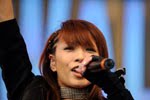Employers will hire more workers this year, and the economy will grow faster than envisioned three months ago, according to an Associated Press survey that found growing optimism among leading economists.
But unemployment will stay chronically high — nearly 9 percent by year's end, the latest quarterly AP Economy Survey shows. A majority of economists say it will be 2016 or later before unemployment drops to a historically normal rate of around 5 percent.
Economists have become more confident 19 months after the worst recession since the Great Depression ended. Lower Social Security taxes and higher stock prices will embolden Americans to spend more and help power the economy, they say.
"People will finally recognize that an economic recovery is under way," said Lynn Reaser, a board member of the National Association for Business Economics. "This won't be a recovery seen only by economists."
The gains this year will be enough to withstand the threats still clouding the economy, the AP survey found. A majority of the economists doubt, for example, that falling home prices and higher mortgage rates will pose a major risk to the economy in 2011.
The AP survey collected the views of 42 private, corporate and academic economists on a range of indicators. Among their forecasts:
• The economy will grow 3.2 percent this year, compared with the 2.7 percent they forecast in October. That would top last year's estimated growth of less than 3 percent.
• Employers will create a net total of 2.2 million jobs. Three months ago, the economists predicted 1.6 million jobs would be added in 2011. Last year, employers added roughly 1.1 million.
• Consumers will spend 3.2 percent more this year than last year. That's stronger than the 2.5 percent growth the economists had forecast in October. And it's nearly double the spending growth that's estimated for 2010.
• Inflation will be 1.8 percent this year, barely more than the 1.7 percent the economists forecast in the previous survey and up only slightly from 1.5 percent last year. The 1.8 percent forecast falls within the range of inflation the Federal Reserve thinks a healthy economy needs.
Among the reasons for the economists' growing optimism: an extension of income-tax cuts, a cut in Social Security taxes for workers, easier access to loans, higher stock prices and a government that seems more sympathetic to the priorities of businesses.
The brighter outlook is also evident among people responsible for hiring.
Jerry Huddleston, human resources manager of the Ozark Natural Foods grocery store in Fayetteville, Ark., said he plans to hire for busy weekend shifts because sales are improving.
The store is generally slow to add jobs. But Huddleston said business is picking up. Customers seem more willing to pay more for organic milk, vitamin supplements and pre-made vegetarian meals.
"I think people are starting to be more confident that the job they have is the job they will have tomorrow," he said.
As the economy gradually strengthens, the economists expect interest rates will tick up, as they already have begun to do. They think the yield on the 10-year Treasury note, now at 3.4 percent, will reach 3.6 percent by midyear and 3.9 percent by year's end. Those higher rates would force up mortgage rates, which tend to track the 10-year Treasury yield.
Yet when asked about a range of threats — from falling home prices and rising energy prices to state budget woes and Europe's debt crisis — the economists called each a minor risk rather than a major risk to the economy.
In the spring and summer, many analysts had feared the economy might slide back into a "double-dip" recession.
"Consumers and businesses are in a better mood," said Nariman Behravesh, chief economist at IHS Global Insight. "They are spending a little more freely. Not a lot more freely, but a little more freely."
That helps explain why Behravesh has lifted his forecast for economic growth in 2011 to 3.2 percent, from 2.2 percent in October.
Still, the Fed said Wednesday that the economy isn't growing fast enough to lower unemployment and still needs help from the Fed's $600 billion Treasury bond-purchase program. The bond purchases are intended to lower rates on loans and boost stock prices, spurring more spending and invigorating the economy.
President Barack Obama still faces risks from voters skeptical of his economic stewardship, according to a new Associated Press-GfK poll. More than half disapprove of how he's handled the economy. Just 35 percent say it's improved on his watch; 40 percent had said so a year ago.
Yet public sentiment may brighten if the economists prove correct in their forecasts. Rajeev Dhawan, director of Georgia State University's Economic Forecasting Center, has raised his estimate for growth this year to 2.7 percent, from 1.8 percent three months ago.
This year "will be better than 2010 in terms of hiring, spending and economic growth," Dhawan said. "Yet unemployment will decline only slowly. At least we're not going backward."
Dave Lindahl Scam




























0 comments:
Post a Comment
We encourage people to contact us with any comments regarding news or any other queries about this site. We will respond you respectively and promptly.
We are going to moderate comments only to avoid unwanted and spam messages.
Thanks for your interest ! ! ! ! ! ! !